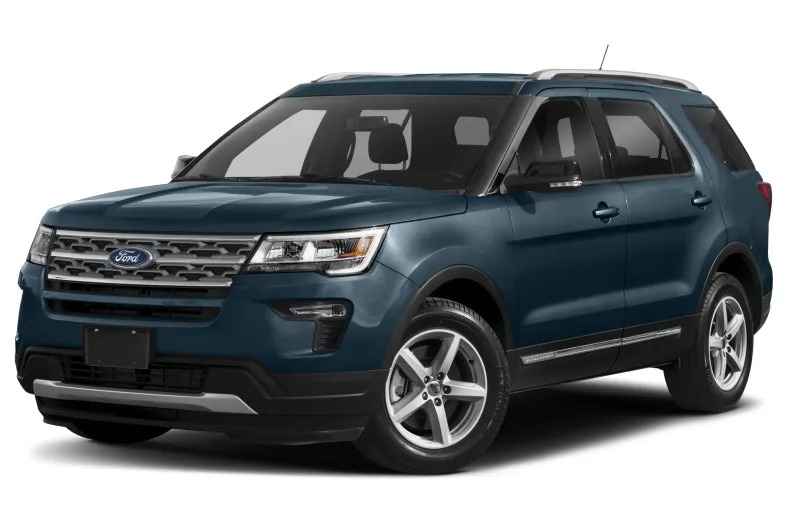Base 4dr 4x4
2019 Ford Explorer
The Ford Explorer is in the ninth year of its life cycle. That is a long, long time in car years, but the mid-size Ford SUV still has some features and talents to recommend. The current generation arrived in showrooms in 2011, and was refreshed in 2016. It's been something of an anomaly in Explorer history: Most generations have been rear-wheel-drive, body-on-frame SUVs, but the current one's a front-wheel-drive unibody crossover. The new model that's coming in 2020 will revert to rear-drive form, and will lead a luxury push at Ford in the next decade.
In the meantime, the 2019 Explorer gains a wider availability of active safety equipment (but not standard in all models, like the smaller Ford Edge), some new trim packages, and a power liftgate on the XLT. Not much incentive against waiting for the new one.
About the same size as a Honda Pilot or Chevy Traverse, the mid-size Explorer's aged styling holds up; if anything, it looks classier than those crossovers that go off chasing edges. It carry seven people, has a vast 81 cubic feet of cargo space with the seats folded flat, and can tow 5,000 pounds. On a wheelbase of 113 inches, the Explorer is sixteen and a half feet long, and weighs 4,900 pounds fully loaded.
The base engine is a 3.5-liter V-6 used in other Fords, from Flex to Fusion. It makes 290 horsepower and 255 pound-feet of torque, and can accelerate from zero to 60 mph in about 8.5 seconds, using the standard 6-speed automatic transmission. Front-wheel drive is standard, and all-wheel drive is available.
The popular 2.3-liter turbo-4 is standard on Explorer Limited AWD, and available on some other models. It's the same engine that's in the Mustang and Lincoln MKC, and is way better than the V-6. It makes 280 horsepower and 310 pound-feet of torque, and has a cool exhaust note.
The high-performance engine is the twin-turbocharged 3.5-liter V-6 making 365 horsepower and 350 pound-feet of torque; it comes with Explorer Platinum and Explorer Sport AWD models. The Sport also gets 20-inch wheels, bigger brakes and a stiffer chassis. It can't run with a Jeep Grand Cherokee SRT, but it's got respectable acceleration for a sport SUV.
The turbo-4 is EPA rated at 22 mpg combined, but many owners report that their mileage doesn't achieve the EPA rating. The twin-turbo V-6 gets an EPA-rated 18 mpg Combined city and highway, just two miles per gallon less than the base V-6, at 20 mpg Combined.
The Explorer earns five stars in its NHTSA crash rating in every category except rollover, but SUVs never ace that one. With the IIHS, the Explorer got top scores in the moderate-front overlap, side impact and roof strength tests, but only Marginal in the small-overlap crash test, which relatively few ace..
Full Review
Full Review
The current generation arrived in showrooms in 2011, and was refreshed in 2016. It's been something of an anomaly in Explorer history: Most generations have been rear-wheel-drive, body-on-frame SUVs, but the current one's a front-wheel-drive unibody crossover. The new model that's coming in 2020 will revert to rear-drive form, and will lead a luxury push at Ford in the next decade.
In the meantime, the 2019 Explorer gains a wider availability of active safety equipment (but not standard in all models, like the smaller Ford Edge), some new trim packages, and a power liftgate on the XLT. Not much incentive against waiting for the new one.
About the same size as a Honda Pilot or Chevy Traverse, the mid-size Explorer's aged styling holds up; if anything, it looks classier than those crossovers that go off chasing edges. It carry seven people, has a vast 81 cubic feet of cargo space with the seats folded flat, and can tow 5,000 pounds. On a wheelbase of 113 inches, the Explorer is sixteen and a half feet long, and weighs 4,900 pounds fully loaded.
The base engine is a 3.5-liter V-6 used in other Fords, from Flex to Fusion. It makes 290 horsepower and 255 pound-feet of torque, and can accelerate from zero to 60 mph in about 8.5 seconds, using the standard 6-speed automatic transmission. Front-wheel drive is standard, and all-wheel drive is available.
The popular 2.3-liter turbo-4 is standard on Explorer Limited AWD, and available on some other models. It's the same engine that's in the Mustang and Lincoln MKC, and is way better than the V-6. It makes 280 horsepower and 310 pound-feet of torque, and has a cool exhaust note.
The high-performance engine is the twin-turbocharged 3.5-liter V-6 making 365 horsepower and 350 pound-feet of torque; it comes with Explorer Platinum and Explorer Sport AWD models. The Sport also gets 20-inch wheels, bigger brakes and a stiffer chassis. It can't run with a Jeep Grand Cherokee SRT, but it's got respectable acceleration for a sport SUV.
The turbo-4 is EPA rated at 22 mpg combined, but many owners report that their mileage doesn't achieve the EPA rating. The twin-turbo V-6 gets an EPA-rated 18 mpg Combined city and highway, just two miles per gallon less than the base V-6, at 20 mpg Combined.
The Explorer earns five stars in its NHTSA crash rating in every category except rollover, but SUVs never ace that one. With the IIHS, the Explorer got top scores in the moderate-front overlap, side impact and roof strength tests, but only Marginal in the small-overlap crash test, which relatively few ace..
Hide Full Review
Retail Price
| Engine | 3.5L V-6 |
| MPG | 16 City / 22 Hwy |
| Seating | 7 Passengers |
| Transmission | 6-spd w/OD |
| Power | 290 @ 6500 rpm |
| Drivetrain | four-wheel |





